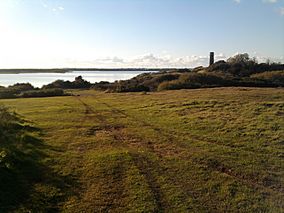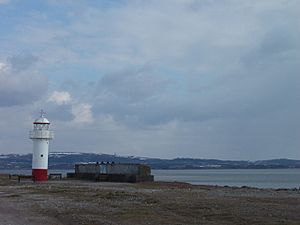Hodbarrow RSPB reserve facts for kids
Quick facts for kids RSPB Hodsbarrow |
|
|---|---|

View over reserve
|
|
| Location | Cumbria, England |
| Operator | Royal Society for the Protection of Birds |
| Website | Hodbarrow |
Hodbarrow RSPB Reserve is a special place for nature, managed by the Royal Society for the Protection of Birds (RSPB). It's located in Cumbria, England, right on the edge of the beautiful Lake District National Park. You can find it by the Duddon Estuary, close to the town of Millom. This reserve is a fantastic spot to see many different kinds of birds and learn about wildlife.
Contents
A Look Back: Hodbarrow's History
From Mine to Nature Reserve
Hodbarrow wasn't always a nature reserve. For many years, until the 1960s, people mined iron ore here. This means they dug deep into the ground to find valuable iron.
When the mining stopped, the ground began to sink in some places. This sinking caused the area to flood, creating a large body of water. This flooded area is now known as Hodbarrow Lagoon. It's a special type of "coastal lagoon" because it's near the sea.
Protecting the Reserve from the Sea
Even though it's a nature reserve now, Hodbarrow still needs protection from the sea. A strong seawall was built by a company called John Aird & Co. This wall was finished in 1905. It helps keep the sea out and protects the lagoon and its wildlife.
Visiting Hodbarrow: What to See and Do
Getting There
If you want to visit Hodbarrow, there's a car park on the Millom side of the reserve. From there, you can walk to the seawall. Another way to reach the seawall is by walking directly from the nearby village of Haverigg.
Birdwatching from the Hide
Once you are on the seawall, you'll find a special building called a bird hide. This hide is a great spot for birdwatching. From inside, you can quietly observe the birds on Hodbarrow Lagoon without disturbing them. It's a perfect place to see many different species up close.
Protecting Our Wildlife: Special Status
Important Areas for Nature
Hodbarrow Lagoon is very important for wildlife. It was first recognized as a Site of Special Scientific Interest (SSSI) in 1983. This means it's a place with special plants, animals, or geology that needs protection.
Later, Hodbarrow Lagoon became part of a larger SSSI called the Duddon Estuary SSSI. The Duddon Estuary is also known as an Important Bird Area. This means it's a globally important place for bird populations. It is also a Special Protection Area, which gives it even more protection under European laws.
Amazing Wildlife at Hodbarrow
Birds that Call Hodbarrow Home
Hodbarrow is a fantastic place for birds. It's especially known for its breeding populations of terns. These are graceful seabirds that come here to lay their eggs and raise their young.
Winter Wonders: Wildfowl
During the winter months, Hodbarrow Lagoon becomes a busy hub for thousands of wildfowl. These are ducks, geese, and other water birds that gather here in large numbers. You might see many different kinds, including:
- Teal
- Wigeon
- Coot
- Mallard
- Tufted duck
- Common pochard
- Goldeneye
- Red-breasted merganser
Sometimes, if you're lucky, you might even spot rarer visitors like:
- Long-tailed duck
- Eider
- Goosander
- Pintail
- Shoveler
It's a truly amazing sight to see so many different birds in one place!


